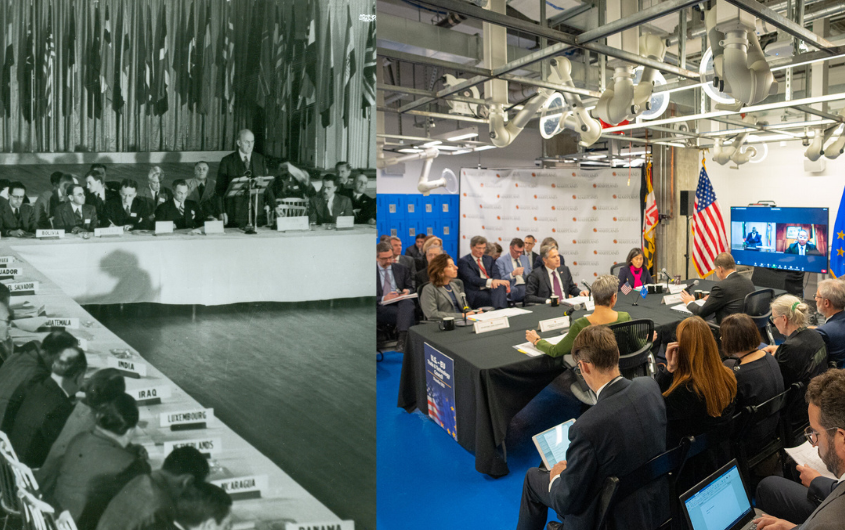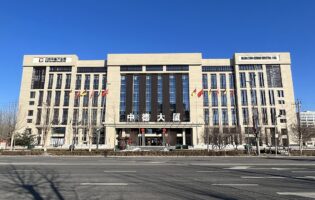
via The World Bank and U.S. Department of State on Flickr
Realism, Idealism, and U.S. Trade Policy

Peter S. Rashish
Vice President; Director, Geoeconomics Program
Peter S. Rashish, who counts over 30 years of experience counseling corporations, think tanks, foundations, and international organizations on transatlantic trade and economic strategy, is Vice President and Director of the Geoeconomics Program at AICGS. He also writes The Wider Atlantic blog.
Mr. Rashish has served as Vice President for Europe and Eurasia at the U.S. Chamber of Commerce, where he spearheaded the Chamber’s advocacy ahead of the launch of the Transatlantic Trade and Investment Partnership. Previously, Mr. Rashish was a Senior Advisor for Europe at McLarty Associates, Executive Vice President of the European Institute, and a staff member and consultant at the International Energy Agency, the World Bank, UNCTAD, the Atlantic Council, the Bertelsmann Foundation, and the German Marshall Fund.
Mr. Rashish has testified before the House Financial Services Subcommittee on International Monetary Policy and Trade and the House Foreign Affairs Subcommittee on Europe and Eurasia and has advised three U.S. presidential campaigns. He has been a featured speaker at the Munich Security Conference, the Aspen Ideas Festival, and the Salzburg Global Seminar and is a member of the Board of Directors of the Jean Monnet Institute in Paris and a Senior Advisor to the European Policy Centre in Brussels. His commentaries have been published in The New York Times, the Financial Times, The Wall Street Journal, Foreign Policy, and The National Interest, and he has appeared on PBS, CNBC, CNN, and NPR.
He earned a BA from Harvard College and an MPhil in international relations from Oxford University. He speaks French, German, Italian, and Spanish.
For nearly 100 years, U.S. trade policy has been judged by where it is situated along a continuum from protectionism to free trade. With the Reciprocal Trade Agreements Act of 1934, President Franklin Roosevelt moved the country decisively away from the protectionism of the infamous Smoot-Hawley tariffs of just four years earlier. That shift toward free trade got significant boosts after World War II with the U.S. entry into the General Agreement on Tariffs and Trade in 1948 and the Kennedy administration’s Trade Expansion Act of 1962.
After the 1960s, U.S. policy became more nuanced, with liberalization efforts balanced by new, coercive tools (like Section 301 of the Trade Act of 1974) enabling successive administrations to use tariffs and other means to respond to unfair trading practices abroad. In retrospect, the 1994 North American Free Trade Agreement (NAFTA) and the establishment of the World Trade Organization (WTO) the following year may be the high point of the U.S. strategy based on free trade. While the George W. Bush administration was able to achieve free trade agreements with several small and medium-sized economies, two mega-deals pushed by the Bush and Obama administrations—the Trans-Pacific Partnership and the Transatlantic Trade and Investment Partnership—never made it past the finish line.
Then came Donald Trump, who repudiated the post-war belief in the value of free trade by imposing punitive tariffs on both rivals like China and like-minded partners like the European Union, blocking new appointments to the appellate body of the WTO’s dispute settlement system, and nearly pulling out of the U.S.-Korea Free Trade Agreement.
But with the arrival of the Biden administration—which doesn’t fit neatly into the protectionism-free trade continuum—an additional lens is now needed to assess the state of U.S. trade policy. Given the major transformations underway in the global economy, a framework borrowed from international relations would help. In parallel to protectionism-free trade, U.S. trade policy should also be considered along a continuum of realism-idealism.
After the destruction of World War II, the United States and its European partners led a major effort to build an international economic system based on an idealist confidence in cooperative international institutions to advance U.S. interests: the GATT and later the WTO, the World Bank and the International Monetary Fund, and finally the G20 in response to the 2008 global financial crisis.
With the arrival of the Biden administration—which doesn’t fit neatly into the protectionism-free trade continuum—an additional lens is now needed to assess the state of U.S. trade policy.
This approach is beginning to look incomplete. The interlinked security and values challenges presented by China’s domestic and foreign economic practices, the existential crisis of climate change, and disruptive technologies like artificial intelligence cannot be managed by idealism alone. A greater realist consideration is needed of the economic balance of power, climate and technological sovereignty, and pragmatic forms of cooperation.
The idealist structures and outlook that took hold after World War II are often referred to as a “liberal international order.” One reason for this is its emphasis on shared liberal values among countries, like individual freedom, high standards for consumers and workers, and a commitment to human progress. And at one end of the realist spectrum lies a mainly values-neutral stance that only a raw assertion of national power within a zero-sum context can promote a country’s interests.
But another, much more benign view—what could be called “liberal realism”—sees the opportunity for building coalitions of like-minded countries to advance their shared values and interests even in a world characterized as much by anarchy as order. This approach may hold the key to ensuring that the United States continues to thrive in a post-idealist global economy.









